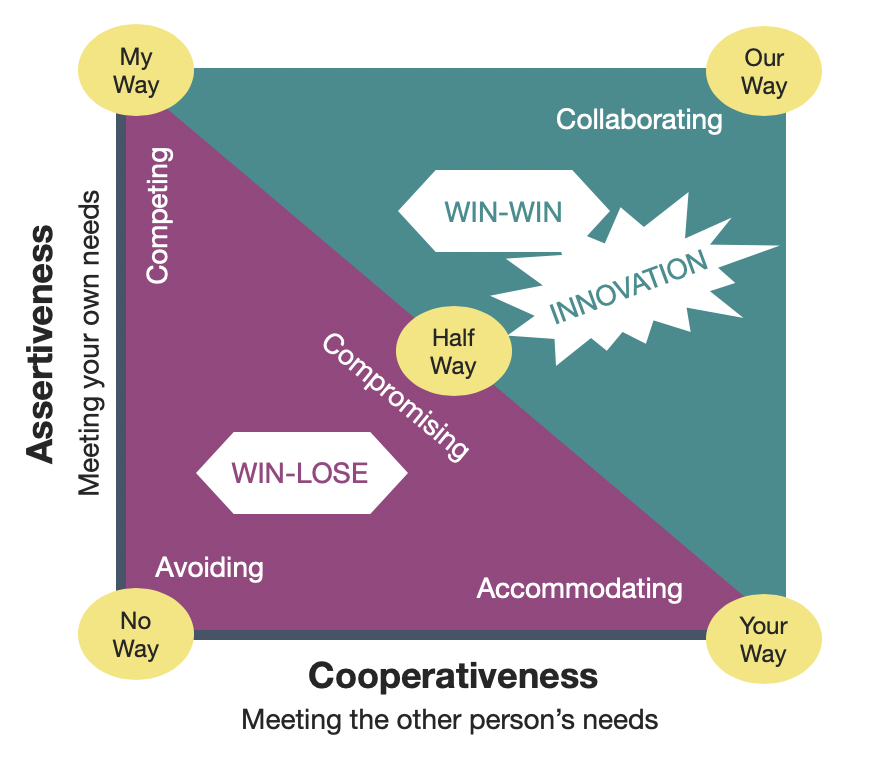“The opportunity to engage in intense, open debate over business decisions is thrilling for teams. They respond by offering the very best of their analytical powers.” (Patty McCord, former chief talent officer at Netflix)
When handled effectively, conflict holds a huge creative potential. If we want to be more innovative, we therefore have to get more comfortable with conflict. The best way of doing that is to teach yourself and your teams better conflict management skills.
This was the key message of my presentation at the Swiss Project Management Conference in Zurich on 5 September 2019.
Thomas-Kilmann Conflict Mode Instrument
The Thomas-Kilmann Instrument offers a simple and intuitive framework for effective conflict management. It defines five basic conflict-handling modes: competing, accommodating, avoiding, compromising, and collaborating.
Your behaviour is function of both the situation and your personality, especially your natural inclinations towards assertiveness and cooperativeness.
While the first four modes represent win-lose situations, collaborating supports innovation and win-win solutions. Collaborating might therefore sound like the ideal solution but, as we will see below, this is not always the case.

Every mode is best depending on the situation
In an emergency, where quick, decisive action is vital, competing might be the best course of action. Accommodating, on the other hand, can be an effective way to build goodwill when an issue is much more important to the other party than it is to you.
Avoiding can be used if the issue is not very important, or if you need to postpone a discussion until a better time, for instance, in the case of stress or emotional overwhelm. If you need to find a quick and mutually acceptable solution to a problem that is moderately important to both parties, compromising is probably the best mode.
Collaborating – the most complex mode
Collaborating requires time, a strong basis of trust and a reward system that actively fosters cooperation and teamwork. When interactions are effective and the concerns of both parties are too important to be compromised, it is worth the effort.
I recommend that you respect the following key principles when using this mode:
- Define conflict management standards: Set the terms of debate explicitly to avoid mean spirited or counter-productive conflict. Avoid the four team toxins.
- Align around something bigger: Agree on what is more important than the separate points of view (e.g. shared goals, ideals or values).
- Show respect and curiosity: Hold a genuine desire to understand the other person’s needs and discover the bases of their view.
- Debate vigorously with integrity: Champion your view based on the merits of your case, not just for the sake of winning the argument.
- Discover creative new win-win solutions: Look for new solutions that satisfy the needs of all parties.
Avoiding overuse
Since our personality also plays an important role, it is useful to become more aware of which behavioural mode(s) you might be unconsciously overusing.
Too much competing might backfire in the long run by creating ill feelings and disengaging people around you. On the other hand, too much accommodating might leave you feeling deprived of influence and recognition, or lead to escalation at a later stage.
If you find yourself devoting too much time to discussing trivial issues that don’t seem to warrant it, you might be overusing the collaborating mode. Conversely, it is also counterproductive to spend too much energy on avoiding issues that need to be faced and resolved.
Finally, excessive compromising might lead to too many sub-optimal solutions and people losing sight of the larger issues.
Assessing conflict situations
In order to best meet your own and other people’s needs, learn to assess the key characteristics of every conflict situation.
For example, ask yourself how important the issue and the relationship are for both people, and if there is enough trust and time to enter into a collaborative discussion. Also assess whether whether cultural norms and the reward system encourage people to share their real needs and concerns.
Apply the mode which is likely to be most effective with care, sensitivity and respect. And, if the situation changes, you can switch to a different mode.
Finally, in order to handle conflict gracefully, always strive to improve your listening and communication skills as well as your ability to manage your emotions!
